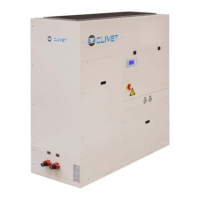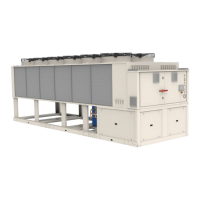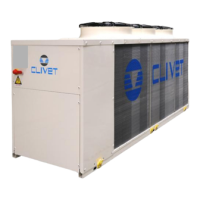
Do you have a question about the CLIVET WSA-XEE 262 and is the answer not in the manual?
Provides instructions for installation, use, and maintenance.
States only qualified personnel can operate the unit.
Highlights potential hazards and need for qualified personnel.
Specifies the unit's intended use for air-conditioning.
Discusses indoor installation requirements and regulations.
Advises on planning periodic inspection and maintenance.
Warns that modifications void warranty and responsibility.
Instructs immediate deactivation and contacting service.
Outlines key training areas for the user.
Advises checking manufacturer website for updated data.
Provides guidance on manual storage and recording interventions.
Explains the serial number label and its information.
States serial number uniquely identifies the unit.
Guides on collecting data for assistance requests.
Advises observing external packaging instructions for storage.
Details checks and procedures for safe unit handling and lifting.
Cautions on careful removal and disposal of packaging.
Illustrates steps for removing fan section for shipping.
Defines functional spaces for unit operation and maintenance.
Details criteria and recommendations for unit installation placement.
Installer's responsibility for drain tubes and safety valve.
Refers to details on page 43 for the fresh air probe.
Considers load losses, air flow, speed, and ducting design for efficiency.
Lists acceptable water quality values and risks of poor quality.
Advises on protecting connections from freezing.
Discusses use and compatibility of anti-freeze solutions.
Specifies requirements for project water flow rate.
Details steps for hydraulic circuit operation sequence.
Installer defines component type and position in system.
Describes procedures for connecting union and pipe.
Recommends filter installation and cleaning accessibility.
Explains the flow switch's function and installation.
Refers to details on page 42 for partial energy recovery.
Refers to details on page 43 for single pump.
Refers to details on page 43 for shut-off valves.
Details electrical data on the serial number label and matriculation plate.
Provides steps for electrical connections and safety checks.
Advises on laying cables to avoid electromagnetic interference.
Mentions fixing cables and avoiding contact with compressor.
Warns against short ON-OFF cycles and using with thermoregulation.
Shows wiring diagram and customer connection points.
Guides on PC connection, configuration, and accessing the unit.
Details remote control types and connection distances.
Describes the PSX mains power supply unit.
Explains Modbus/RS485 communication, parameters, and cable requirements.
Details LonWorks communication, LEDs, and cable types.
Details BACnet IP communication, LEDs, and server status.
Outlines start-up operations by qualified technicians.
Lists checks before unit power supply and operation.
Details the step-by-step sequence for unit power ON.
Checks for oil stains, pressure, and valve status.
Procedures for hydraulic system cleaning, filling, and pressure testing.
Verifies ground connection, conductor tightness, voltage, and phase balance.
Advises on connecting oil resistances before compressor start.
Checks operating temperatures, voltage, and absorption.
Checks connection and enabling of remote controls and sensors.
Explains accessing and modifying demand limit parameters.
Guides on accessing and modifying climatic text parameters for setpoint.
Explains accessing and modifying water reset parameters for setpoint.
Details ECOSHARE function for managing multiple units.
Discusses setting operation modes for networked units.
Explains how to check water flow rate and pressure drops.
Discusses operation at reduced load and warranty implications.
Explains scroll compressor rotation direction and potential issues.
Lists data to identify for controlling unit operation over time.
Refers to regulations for installation and periodic verification.
Explains the function of INFO, ALARM, and CANCEL LEDs.
Lists display variables and their descriptions.
Describes the symbols and functions of the control keys.
Guides on changing the unit state (OFF, ECO, ON, Pump On).
Guides on changing the operating mode (Cool/Heat).
Details how to modify setpoint values for different modes.
Explains setting events (Off, Eco, On, Recirculating) for each weekday.
Covers keyboard settings adjustments.
Guides on identifying and resetting alarms, and alarm code meanings.
Guides on displaying machine state and status codes.
Lists general status codes and their detailed descriptions.
Lists status codes for circuit 1, including temperatures, pressures, and controls.
Lists status codes for thermostatic control C1 and valve positions.
Lists status codes for recovery circuit 1, including pressure and temperature.
Lists status codes for master-slave units and setpoints.
Lists status codes for hydronic module, pumps, and inverters.
Lists status codes for energy meter, including voltage, current, and power.
States maintenance by authorized centers and its benefits.
Details inspection frequency and tasks every 6 months.
Advises creating a booklet to record unit interventions.
Advises on procedures for long periods of inactivity and re-start.
Emphasizes cleaning the exchanger for thermal exchange.
Advises checking the water filter for impurities.
Lists checks for circulating pumps, including leaks and bearing status.
Mentions flow switch operations and cleaning.
Lists checks for electric fans, fixing, bearings, and protection covers.
Advises cleaning the air coil and wearing protective gloves.
Advises not to remove the seal without authorization.
Lists checks for crankcase heater closure and operation.
Details procedures for system evacuation and discharge.
Describes partial energy recovery for hot water production.
Details single pump, CSVX valves, and fresh air probe functions and positioning.
Covers installation, components, jack, and procedures for anti-vibration mounts.
Provides dimensions, foot prints, and mounting points for antivibration supports.
Instructs authorized personnel to disconnect the unit and recover refrigerant.
Directs to send the unit to authorized centers for disposal.
Explains EC RAEE directive for waste electrical equipment.
Lists common situations not controlled by the manufacturer that pose risks.
Defines the danger zone where only authorized operators may work.
Warns about risks during handling if not done properly.
Highlights risks associated with incorrect installation.
Covers risks like burning smell, accidental contact, and panel fixing.
Details risks related to electric connections and components.
Warns about injuries from contact with fans or transmissions.
Covers risks related to refrigerant expulsion and fires.
Warns about leaks and projections from hydraulic parts.
Presents comprehensive technical specifications for the unit.
Details sound emission levels and operational temperature limits.
Lists admissible water flow rates and exchanger pressure/operating ranges.
Provides detailed dimensional diagrams for various unit sizes.











